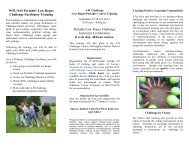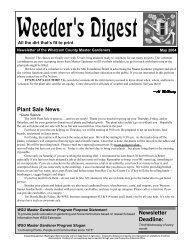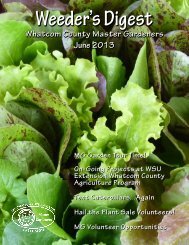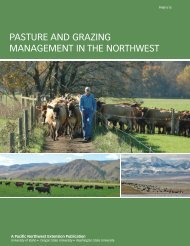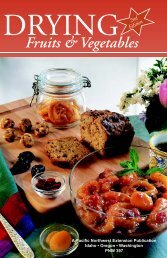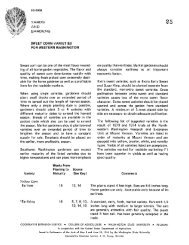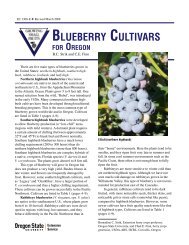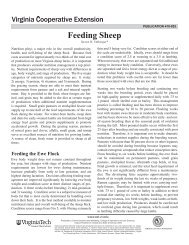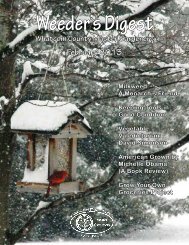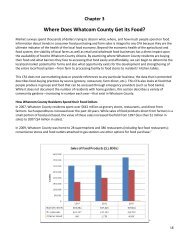August - WSU Whatcom County Extension - Washington State ...
August - WSU Whatcom County Extension - Washington State ...
August - WSU Whatcom County Extension - Washington State ...
You also want an ePaper? Increase the reach of your titles
YUMPU automatically turns print PDFs into web optimized ePapers that Google loves.
Weeder’s Digest<br />
Plant of the Month............................ By Cheryll Greenwood Kinsley<br />
Kale<br />
Family: Cruciferae<br />
(Mustard family)<br />
Genus: Brassica<br />
Species: oleracea<br />
Texas A&M University Department of<br />
Horticultural Sciences and Aggie Horticulture<br />
This month’s article is as much a reminder for me as anything else, to start some kale from seed in<br />
flats about now. I love the look of our gardens this time of year—exuberant, more than slightly overgrown,<br />
and very colorful. In the vegetable plot as well as the flowerbeds, everything tumbles together:<br />
blossoms, fruit, and seedheads, twining vines and leafed-out branches. As the summer progresses,<br />
however, it will be time to start taking things out, whether nasturtiums or petunias, and there will be<br />
holes here and there. While I won’t be able to recapture summer’s exuberance as<br />
we move into fall, I can be prepared with some fresh stock to cover patches of bare<br />
earth.<br />
For years I dismissed ornamental kale as too garish. There was something<br />
almost artificial about that combination of pink, purple, and teal that didn’t sit right<br />
with me. But tastes change. New varieties become available. And a couple of years<br />
ago I found myself coveting some “flowering” kale with either pure red or clear<br />
white centers clustered within outer leaves of true, deep green. The only trouble?<br />
They were pretty pricey, particularly if I wanted a number of them to line a walkway<br />
or fill several containers.<br />
But for half the price of a single plant at the nursery, I can buy one packet of<br />
seeds. The trick is to start them at the right time, in the right way, so I’ll have as<br />
many pretty heads of ornamental kale as I need.<br />
Now is the time—don’t wait past early <strong>August</strong>—and flats are the way to go.<br />
I sow leafy kale—the kind I plan to eat—directly into the ground, in the place set<br />
aside for vegetables. Unlike chard, it doesn’t suit me to mix it in with my ornamentals.<br />
I like to harvest the thinnings and then keep taking the outer leaves while<br />
they’re small to use in September salads. As the weather cools, the plants grow bigger and their leaves<br />
become both tougher and sweeter, making them perfect for pot greens by November. So the kale I plant<br />
to eat really needs a place of its own.<br />
But the kale I plan to admire is treated a little differently. By sowing seeds in flats now, I’ll have starts to transplant into small<br />
pots in a month. And by the first of October, if I tend them properly, I’ll have a number of pretty little heads of ornamental kale to<br />
put along the walkway or in containers by the front door. I might choose ‘Sunset’ or ‘Sunrise’—can you guess how these differ in<br />
color?—or the particularly attractive Nagoya mix for pure white and pure red. The plant breeders have been busy with kale during<br />
the last two decades, taking the most ancient of the Cruciferae to new aesthetic heights for our modern sensibilities. What we call<br />
kale is the forerunner of broccoli, Brussels sprouts, and most cabbages. The Greeks ate it, the Romans followed suit and took it on<br />
the road with them all over Europe.<br />
The trick to growing kale is to make sure it has cool weather as it matures. But it also needs warmth to germinate. So for our<br />
region, it’s the perfect fall crop—particularly the ornamental varieties. Starting seeds in flats, outdoors, now avoids many of the<br />
problems associated with starting seeds indoors in late winter and early spring. Better air circulation, and fresh air in general, means<br />
less chance of damping-off. The starts are likely to be sturdy and healthy. By transplanting them into small pots and keeping them<br />
well-watered and lightly fed, you’ll be able to choose the best-looking heads as ornamental features. And if you use a seed mix,<br />
you’ll have a clear fix on the colors you’re dealing with so you can place them where the combinations will please you. One other<br />
advantage: not all of them will look like the ones in the catalog. Some will be irregularly shaped, some will look lumpy. You’ll be able<br />
to select the best of the lot. Plant them in the ground up to their first set of leaves, and you’ll keep them from growing lanky and<br />
flopping over. The cool fall weather will bring out their color, once they’re safely tucked in the ground.<br />
And yes, you can eat any ornamental kale that doesn’t make the cut. It’s not as tasty or tender as the culinary varieties—it’s<br />
bred for looks, remember—but it’s still nutritious and pleasant to eat when you toss a handful of leaves cut into strips into soup, for<br />
example, during the last few minutes of cooking time.<br />
So, if you start some ornamental kale right away, no later than mid-<strong>August</strong>, you’ll have the opportunity this year to have your<br />
kale and eat it, too.<br />
Hovander Update<br />
Projects at the demonstration garden are looking well tended as late summer nears. We’ve had lots of volunteers lately to<br />
zero in on the weeds in the pumpkins and corn maze.<br />
We’ve experienced the usual problems such as lots of cabbage worms and slugs. And, the long-standing ritual of sampling<br />
fava beans will not happen this year as our plants couldn’t survive a peacock attack!<br />
We’re hoping to have a big turnout at the <strong>August</strong> MG picnic here at Hovander Park. While here—be sure to check out the<br />
various projects that volunteers have worked so hard on this year.



